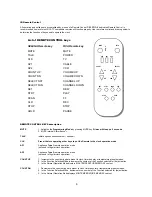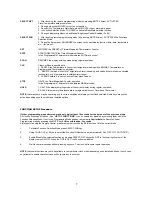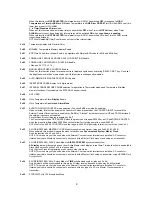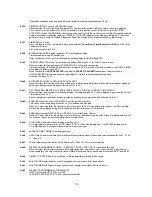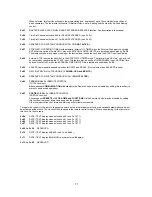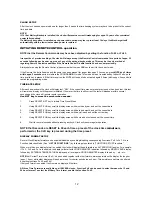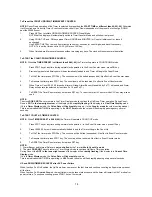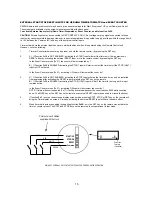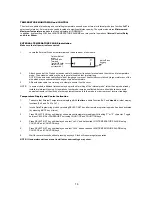
20
NOTE: In systems with a WIRED Impulse Synch transmitted through a separate Cable, High Voltage or Low
Voltage,
The operation is similar except SIGNAL Frequency selection is NOT NECESSARY and the function Fn 13 must be
also enabled. The sync signal should then be connected to a pair of designated terminals on the back panel of the
clock.
2-WIRE (twisted pair) Sync System
Large System Clock installations may be synchronized by linking them together in a communication network using a “Twisted
Pair“ cable. Slave Clocks receive data transmitted by the Master Clock or a PC and interpret it to synchronize themselves with
the master.
There are two different configurations for
Slave
operation:
1.
SLAVE
FOR TIME SYNC only
Enabled by Fn 34 (for all protocols)
The slave will interpret Time data from the Master and set its own internal clock “in sync” with it.
In this configuration, even if data connection is lost, the Slave will continue accurate timekeeping based on its latest
successful sync data reception.
A.
To use Standard SELENA Time Sync communication protocol enable Fn34 only
B.
To use ASCII Time Code Format “0,1,2 or 3” enable both Fn34 and Fn46 and Select Format by
setting Fn11 and Fn12 as required
2.
SLAVE
AS DISPLAY REPEATER
(This option is allowed only when SELENA Time Sync protocol is used)
Enabled by Fn 33
The Slave will repeat all display data as transmitted by the Master.
In this configuration the Slave will not be able to perform any other display functions except when it is put in a
programming mode via the Remote Control.
ASCII TIME CODE protocol.
To select the Format for the ASCII Time Code protocol,
Enable the function Fn46
and set the following functions as required:
Fn13
Fn12
Fn11
Format “0”
0
0
0
SELENA may be set as a Slave or as a Master
Format “1”
0
0
1
SELENA may be set as a Slave only
Format “2”
0
1
0
SELENA may be set as a Slave only
Format “3”
0
1
1
SELENA may be set as a Slave or as a Master
Lathem Format
1
1
1
SELENA may be set as a Slave only
It is required that the Data Packets must be broadcast with a gap between them of at least 100 ms of no data. Otherwise the
clock will ignore data received too soon after the previous packet.
One ASCII time code packet must be broadcast by the Master once every second ( in Lathem protocol once a minute ), at the
beginning of each second.
Data structure is shown below:
Format 0: (CR)(LF)I(^)(^)DDD(^)HH:MM:SS(^)DTZ=XX(CR)(LF)
Format 1: (CR)(LF)I(^)WWW(^)DDMMMYY(^)HH:MM:SS(CR)(LF)
Format 2: (CR)(LF)IQYY(^)DDD(^)HH:MM:SS.sss(^)LD
Format 3: 0003(^)YYYYmmdd(^)/-)HdHdMdMdD#(CR)(LF)
where:
CR = Carriage Return
LF = Line Feed
I = Time Sync Status (space, ?, *)
^ = space separator
DDD = Day of Year (001 - 366)
DD = Numerical day of month ( ^1 - 31 )
YYYY = Year ( 2002, 2003, 2004, etc… )
WWW = Day of Week ( MON, TUE, WED.. etc..)
MMM = Month ( JAN, FEB, MAR...etc…)
YY = Year without century ( 02, 03, 03 etc…)
HH = Hours ( 00-23 )
: = Colon separator
. = Decimal separator
+,- = positive or negative UTC offset ( time difference from UTC )
# = On-Time point
MM = Minutes ( 00-59 )
SS = Seconds ( 00 - 60 )
sss = Miliseconds ( 000 - 999 )

